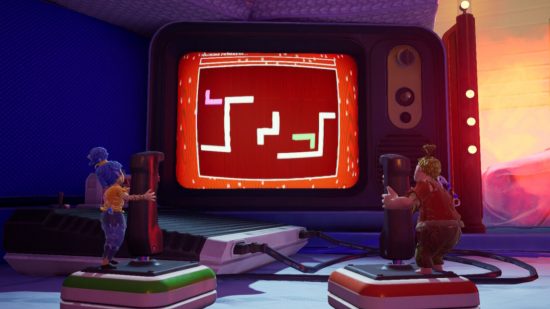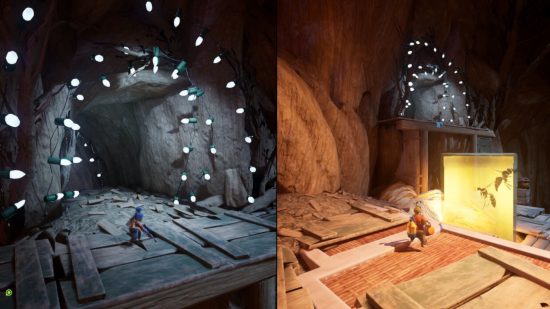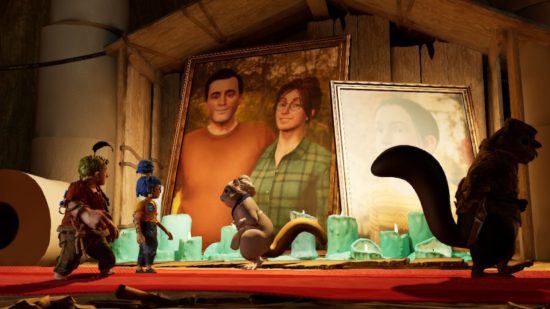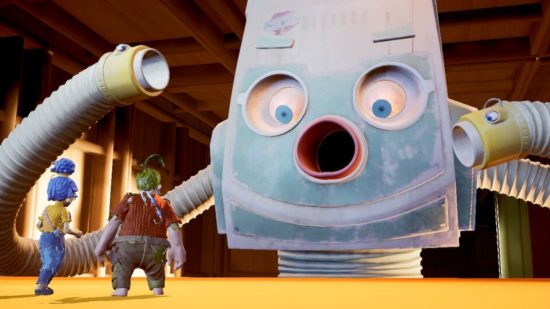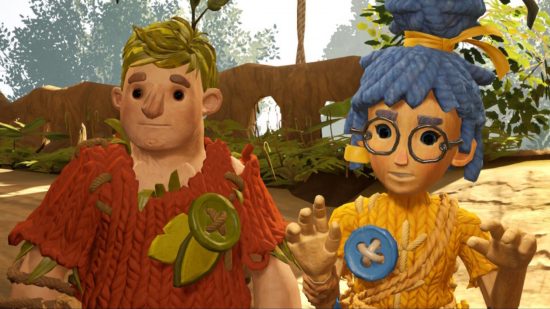Even in my field, it’s rare you find yourself face-to-face with an industry icon. Still, somehow, last week I found myself with fifteen minutes in the company Josef Fares, the head of Hazelight Studios, alongside Louis Polak and Scott Cromie from Turn Me Up Games, to talk about It Takes Two finally arriving on Nintendo Switch.
For context, there are outspoken figures in the gaming industry, and then there’s Josef Fares. By no means is he offensive. If anything, his will to talk about bad industry practices surrounding issues such as microtransactions or sexual harassment lights him up as either a paragon of equality for some, or a virtue-signalling wokeist for others. Either way, his “fuck the Oscars” moment back at the 2017 Game Awards led to a path of heightened success, fame, and memeification that would reach its peak when he took to the same stage four years later to accept the award for Game of the Year in 2021 for It Takes Two. Basically, he’s a big deal, and so is his game.
Now, less than a full year later, the much-lauded title is coming to Nintendo Switch, with the safe hands of Turn Me Up Games on porting duties after its success with Switch versions of Borderlands and Tony Hawk’s Pro Skater 1+2. It seems natural that the co-op hit is coming to the home of family-friendly titles, and as I’ll get into later, it’s possible that the Nintendo Switch might be the intended spiritual home of It Takes Two all along, even if it took the longest time to find its way back.
In terms of the porting process, Cromie and Polak from Turn Me Up both sang from the same hymn sheet as to how the game feels like a “natural fit for the console”, despite there being some challenges to bring the shrunk-down world to life on the smaller screen of the Switch, especially in split-screen. They’re right, though. You don’t need the TV screen for this one, with the free download friend pass version of the game on the eShop, so long as you own a copy, you can get cosy with your significant other in a pillow fort, safely protected from the outside world.
Hazelight’s game also presented some difficulties for the porting squad at Turn Me Up Games thanks to its generous helping of levels and mechanics, with Cromie pointing out “the variety and complexity of every level was really the biggest challenge”. It makes sense as to how this might be a challenge, even from someone with no development experience such as myself, with mechanical nods to titles like Diablo, Guitar Hero, and Street Fighter – to name just a few – changing the mechanics often multiple times during a level.
One of the most remarkable elements of It Takes Two is how it manages to perfectly capture a tiny world like that of Honey I Shrunk The Kids but with enough scope and scale to feel like there’s plenty to see and explore. I asked Fares about the team’s inspiration for the miniaturised world of their game, expecting to hear about the influence of the Rick Moranis-led franchise or maybe even the Borrowers or Toy Soldiers, but instead heard the studio lead wax lyrical about the influence of Pixar and Nintendo on the game.
Fares told me, “I would say one of the main inspirations is the Pixar movies, I mean, how they look and feel, that’s pretty much what we went for”. If that is indeed what the developers were aiming for, it’s a clear success. The tiny world of It Takes Two is colourful, it has innocence and depth in equal measure, and moreover, it’s a world designed to help tell the story. There’s not a single part of the game world that feels like filler, or pieced together late in development. Instead, there’s a cohesive environment that reflects Toy Story most obviously, but captures that larger Pixar aesthetic in terms of both world and narrative design.
In terms of inspiration from the Japanese developer giant and creator of the Switch, Fares goes as far as to describe It Takes Two as “a love letter to Nintendo”, with his influence not just for the tiny world, but the abundance of mechanics throughout this adventure, clearly taken from a love for 90s era Nintendo titles like Mario 64 or Banjo Kazooie. What both Nintendo and Pixar share, according to Fares, is clarity and a certain innocence, with colourful worlds that often have a hidden depth of emotion and adventure.
Those who are yet to play all three Hazelight titles might not be aware, but the studio has built something of a reputation for itself for bringing back the couch co-op, especially in its last two releases. I asked Fares if this idea of co-op games had been a sort of mission statement from the start of the studio, or if the co-op nature had naturally evolved through the development of each game.
“I really want to play something that I could relate to, it’s not just a drop in drop out, it’s not just the single player that has an add-on co-op mode, it’s actually something made written from the beginning.” He goes on to elaborate a little further, explaining that the driving factor behind Hazelight games is that they have to be something the team themselves would enjoy playing, and that whether it was for the studios’ first game Brothers, or the latest title published by EA, it’s what the team want to play that rules over audience and publisher expectations, and with over five million copies sold, I doubt that anyone is likely to argue with this working method.
With the trajectory of Hazelight Studios looking remarkably like the stonks meme, with the team going from strength to strength between Brothers, A Way Out, and It Takes Two, I asked Fares if he and the team felt a growing sense of pressure with each title, and if that pressure had mounted even further following on from the critical and commercial success of his latest game.
If there is any pressure, Fares finds it easy enough to laugh it off. His overall answer can best be distilled into his own words, “if we believe in something, we will go with that”. He says that in spite of the audience expectations, or even those of EA when it comes to It Takes Two and future Hazelight projects, the team of core developers always comes first, and their ideas are foremost in navigating game design.
Finally, on the topic of Hazelight’s work in general, rather than just the Switch port of It Takes Two, I asked Fares about the cinematic feel of his games, and what inspires it. I hadn’t planned on asking this question, even though Fares’ association with the world of cinema is well known, until Pixar popped up in the conversation, and I wanted to dig a little deeper into how film influences the work of Hazelight in general.
“I think one of the biggest things is pacing. Pacing is something that I’ve learned a lot, and I think that’s one of the reasons when you play our games, people feel that they know they feel that they don’t get bored, that something new is always happening. And that is something that is common in movies. You don’t want the audience to get bored”. It’s interesting how Fares opts for pacing as his key tenant in producing narrative media, using it as the defining factor between good games and excellent games, like his own, through how they consistently engage players.
One of the most interesting things about my interview with Fares is that he has a genuine self-awareness about what works most effectively in his and his studio’s games, though this never comes across as complacent or show-offish. This is actually quite rare in the industry, with bigwigs and studio execs often most enthusiastic about things their audience couldn’t care less about (I’m looking at you NFTs). Fares rallies against this idea of the greed over art studio lead, and you can tell that attitude oozes out across the ever-expanding staff at his studios.
All in all, for someone who hopes that there’s still a beating heart and a sense of artistic duty in the world of video game development, my time with Fares and the guys from Turn Me Up Games is frankly a relief. To know that last year’s game of the year was won by a team that rally against the demands of the industry, successfully, I might add, spearheaded by someone who is slowly becoming a figurehead for the continued idea that games should be an art form is a blessing in an industry that lauds over profits, and as a writer who spends most of his day politely declining interviews with NFT projects and crypto-infused titles, it’s nice to know that the future isn’t quite decided yet, not so long as there are developers like Hazelight, and games like It Takes Two.
For more chats with studios and developers, be sure to see our retrospective Monument Valley interview, Yu-Gi-Oh! Cross Duel interview, and Yoko Taro interview (the creator of Nier Automata, for those who don’t know). Or, if you want to know more about the Switch port of Hazelight’s best-selling title, check out our It Takes Two review.
